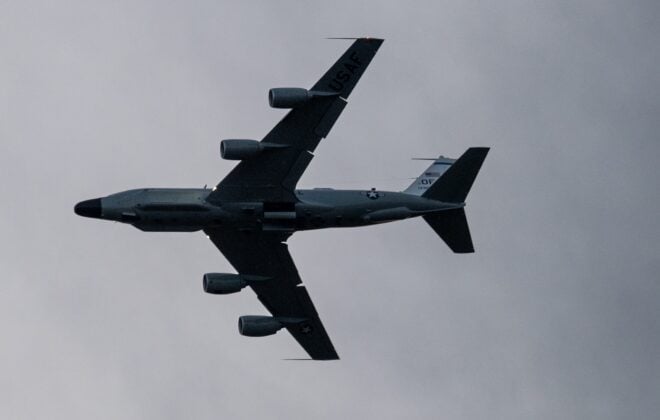
A U.S. Air Force reconnaissance aircraft conducted a surveillance mission near Russia’s northern region on August 28, according to a report from the defense outlet Militarnyi.
The Boeing RC-135V Rivet Joint was detected on the online flight tracking platform Flightradar24 as it operated close to the Murmansk area. The aircraft, equipped with advanced sensors and antennas, is designed to intercept and analyze electronic signals across long distances.
According to Militarnyi, the Rivet Joint took off from Royal Air Force Mildenhall in the United Kingdom and flew through Norwegian airspace before reaching the Barents Sea region. Once off the Russian coast, the plane executed several monitoring loops near Murmansk, a region that hosts a major concentration of Russian military facilities, including naval and strategic assets.
The RC-135V/W Rivet Joint, operated by the U.S. Air Force, provides near real-time intelligence collection, analysis, and dissemination to theater and national-level decision-makers. The aircraft is considered one of America’s most capable airborne intelligence-gathering platforms, supporting missions worldwide.
The report said the flight near Murmansk is viewed as a noteworthy development, reflecting the continued pace of U.S. and NATO reconnaissance operations along Russia’s borders. Such missions have increased in frequency since Russia’s full-scale invasion of Ukraine, with Allied forces closely monitoring Russian military activity in the Arctic and northern seas.
The Rivet Joint’s role is to detect, intercept, and exploit adversary communications and radar signals, giving commanders a detailed picture of the operational environment. Its ability to fly for extended durations and cover large areas makes it an essential tool for intelligence gathering.
While the U.S. routinely conducts reconnaissance flights in international airspace, operations near Murmansk carry added weight due to the area’s military significance. Murmansk Oblast is home to Russia’s Northern Fleet and multiple strategic bases that play a central role in Moscow’s nuclear deterrent and Arctic deployments.
The August 28 mission underscores the continued importance of intelligence flights in supporting NATO’s situational awareness on its northern flank. Although no direct encounters with Russian aircraft were reported, such missions are often shadowed by Russian fighters in the region.